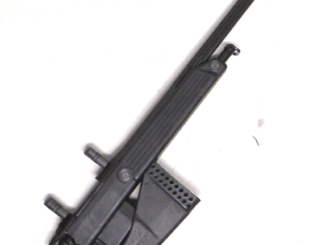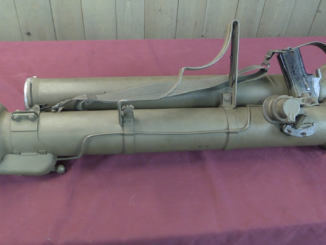In 1936, Lewis Nolan Nomar patented this device, which is basically a large 40-round magazine for the 1911 pistol. He envisioned a military use for the device in trench raiding, giving men a compact weapon with a large capacity. Unfortunately for him, the device was both remarkably (and unnecessarily) heavy and obsolete the day it was patented. Not only was trench warfare a thing of the past, but submachine guns could and would do the job of his device better than it could. Ultimately, I believe only two of these were made and was never formally tested by the US military. Nomar may have also experimented with adapting it to other handguns beyond the 1911, although I cannot find any firm evidence either way on that point.
Related Articles

Light MGs
More Stoner Documents
Thanks to reader Steven B, I have a couple additional documents on the Stoner 63 to post, and also a cleaner copy of the Stoner LMG manual. Thanks, Steven!

Uncategorized
Grendel SRT: KelTec SU-16 Meets Sako Hunting Rifle
Correction: The SRT used the Sako AII action, an updated L579 (not the L357) action. George Kellgren is the brains behind KelTec and all their unorthodox designs. But before he formed KelTec, he created Grendel […]

Artillery
M20A1B1 Super Bazooka – It’s a Super Bazooka. Need I Say More?
The US was one of the few major military powers that went into World War II without a substantial infantry antitank weapon. Most countries had an antitank rifle of some sort, but the US just […]

“Not only was trench warfare a thing of the past”
I am not sure that they thinked in 1936, that trench warfare is past. Especially looking at trends in British tank development, however maybe in USA it was past, can anybody point me to any 1936 US Field Manual dealing with tactical art of war?
“Not only was trench warfare a thing of the past”
I’m sure that anyone who might have spoken this way to an audience of generals in 1936 would have been instantly laughed out of the room — even if it had been true.
But of course it wasn’t true –just yet– as the Spanish Civil War, which had started that same year, would continue to use WWI-style trench-fighting, though to a lesser degree.
“device was both remarkably (and unnecessarily) heavy and obsolete the day it was patented.”
And (at least for me) looks as less comfortable to use that automatic pistol with detachable stock or carbine, as it is not shoulder weapon.
Well, there was a modification of the Steyr M1912 that replaced the usual grip with a stock and complicated spiraling 60 round magazine inside said stock. The inventor of the system was a retired Austrian army officer, Arthur Kottas, and his system was patented in America in 1923.
US 1451339 is what you should read for details… And I warn you, the magazine is still fed by stripper clips…
“magazine is still fed by stripper clips”
But in this case it made some sense, as it allows loading when magazine partially empty.
A cursory search found these patents. Plug these into your favorite patent search engine:
US2066361 – The original magazine / stock
US2114311 – A more perfected version. From the outside, this looks more like the example Ian is showing.
US2167672 – A sub-machine gun that shows this magazine as its stock.
US2197313 – The related clip.
US2226207 – A magazine rifle with an unrelated, circular feed mechanism.
US2900878 – An unrelated sub-machine gun patent.
Enjoy!
Oh, many thanks!
Are you sure that is not a prosthetic leg with a 1911 foot?
I’m left wondering if this magazine was intended for a select-fire 1911 or just a regular pistol.
Wasn’t there some Trench warfare in Korea and the Vietnamese tunnels although not trench warfare was pretty similar if not worse?
Maybe we should try to define exactly what “trench warfare” means or should mean, whether its broadly, the simple act of digging a trench of some kind to shoot from, or more narrowly, the elaborate system of defence-oriented excavations, tactics, and emplacements employed between European forces on both sides fighting head-to-head in open terrain in WWI especially, that established a definable front line.
Since it was the advent of large (and numerous) aircraft in the early 20th century that could instantly take the war anywhere and basically obliterated the very concept of a front-line, in what category should we put 3rd world militaries that don’t have such resources and are therefore relegated to fighting the old-fashioned way?
The battle fronts between Iraq and Iran in their long and fruitless war in the 1980s could well be described as a type of trench warfare (though shifting desert sands often made *berm* warfare more practical), but against a First World military power such as the United States such strategies become instantly useless.
I would propose another question: if World War One had continued on as a stalemate indefinitely, at what point would its trench warfare have been forced into retirement?
In that case, the developmment of heavy bombers, fighter aircraft, and paratrooper planes might have been moved up a decade or so, making the continued construction and defense of static trench positions impractical within perhaps the next 5 or 10 years past 1918. Just a wild thought.
Concentrated tank formations with infantry working with it as a team would have made the trenches obsolete in another year. As it was Germanyand Austria Hungary were collapsing by the end of 1918. That’s why they sued for peace. They ran out of men, money and food before the European Allies did.
“Since it was the advent of large (and numerous) aircraft in the early 20th century that could instantly take the war anywhere and basically obliterated the very concept of a front-line”
This is not true (I assume that early 20th century mean 1900s)
“In that case, the developmment of heavy bombers, fighter aircraft, and paratrooper planes might have been moved up a decade or so, making the continued construction and defense of static trench positions impractical within perhaps the next 5 or 10 years past 1918. Just a wild thought.”
See Plan 1919, which call for mass usage of tanks:
http://worldatwar.net/chandelle/v2/v2n1/1919.html
” Just a wild thought.”
And, if for some, massive tank usage plan, couldn’t be introduced there was alternative: https://en.wikipedia.org/wiki/Plan_1919#The_Chemical_Plan
I vaguely recall a photo, but can’t remember where, of a WW1 period M1911 with an extended magazine for aircraft use (20+rounds?) patented by a London gunmaker (Beesley?). Together with a wire basket to catch the empties. The latter not for reloading purposes but to keep them out of the prop (or the pilot’s face!). The Vickers Gunbus having a gunner up front and a pusher prop at the rear. I have not come across any references to such devices of that period since.
“WW1 period M1911 with an extended magazine for aircraft use”
http://www.iwm.org.uk/collections/item/object/30031199 states that:
It has been suggested that ‘O.B.’ refers to the Naval Ordnance Board, and this is one of 57 .45 ACP Government Models obtained from the trade in August 1916, and issued to the Royal Naval Air Service with British-made Beesley 20 round magazines. This would make it one of the rarest British service pistols.
Now I found also picture: https://forums.1911forum.com/showthread.php?t=355944
(post from 03-05-2012, 02:12 AM)
This was obviously inspired by/an imitation of/an attempt to one=up the 32-round “snail” magazine developed for the Luger during the Great War.
Certain parts of the Eastern Front that were largely static from 1942 to 1944 in the central took on a W W I look until Operation Bagration broke that front wide open.
I like the ‘springy thing’ technical jargon used.
“springy thing”
This reminded me: http://polandball.cc/comic/history-of-yucatan/
Thank you Daweo for the links. It was pleasing to confirm my vague recollection of something I had read many years ago. My memory was focused by the fact that my first c/f pistol, a mint 1911 s/n C16??? was acquired at the time, 1970, for the sum of GB£25!! ($65?).
Had Mr. Nomar produced his mag-stock in 1914 it may well have been taken up by the R.F.C (Royal Flying Corps) or, more likely, the R.N.A.S. (Royal Naval Air Service).